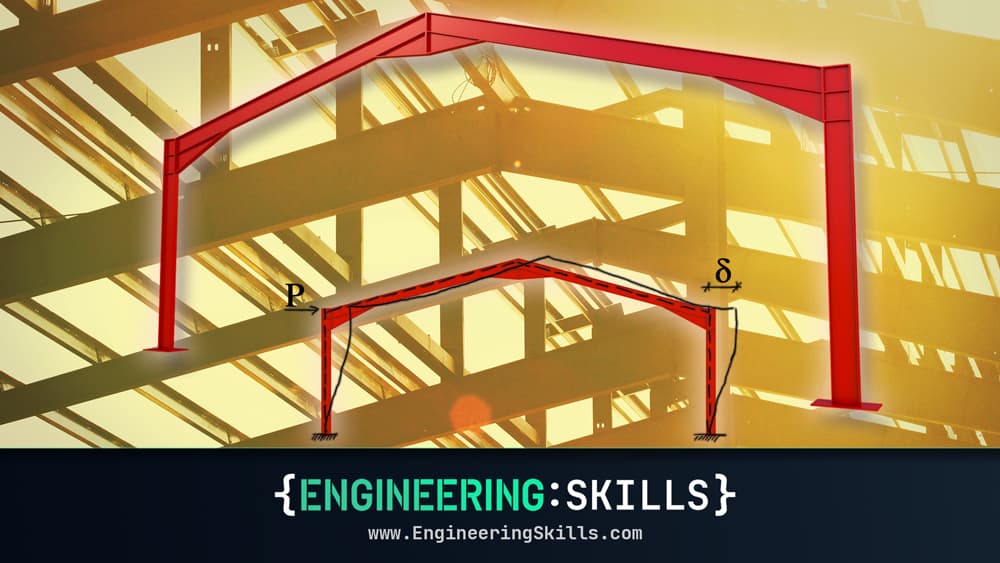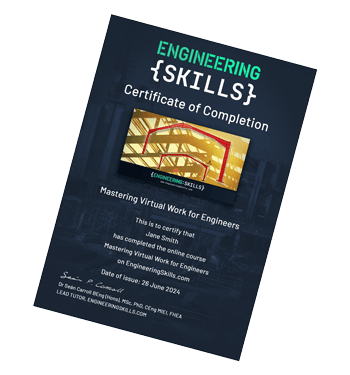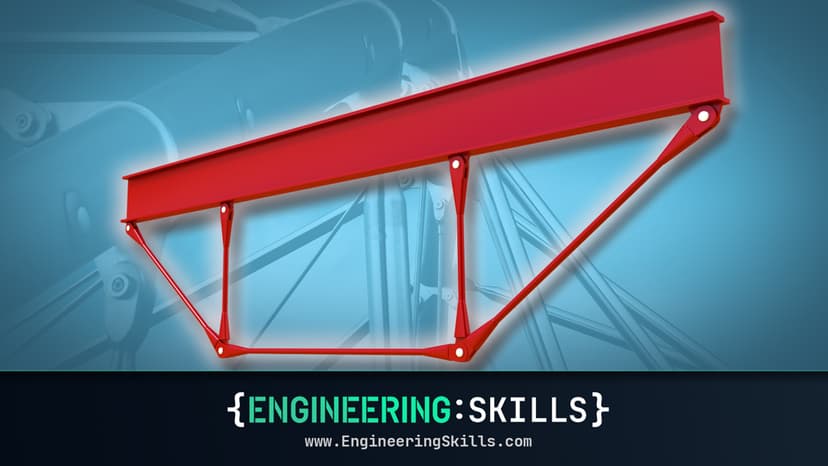
Mastering Virtual Work for Engineers
Analyse complex beam and frame structures using Virtual Work.
- You will have a complete understanding of the Principle of Virtual Work, its origins and how it can be applied to bending behaviour.
- You will have robust, repeatable solution strategies to apply Virtual Work in the analysis of beam and frame structures in bending.
- You will be able to use Virtual Work techniques to calculate unknown displacements in beams and frames under load.
- You will be able to use Virtual Work techniques to calculate unknown reaction forces for beam and frame structures.
In this course you will develop analysis strategies that allow you to apply the Principle of Virtual Work to beam and frame structures. In order to fully leverage this powerful engineering principle, you need to be able to apply it to structures that experience bending. That’s the focus of this course.
As an engineer, a fundamental skill is being able to estimate how a structure will deflect and by how much! The Principle of Virtual work allows us to develop extremely efficient analysis techniques to accomplish this task using only hand calculation. By the end of this course you will be confident in calculating unknown deflections for the majority of civil engineering structures you’re likely to face. More importantly you’ll understand exactly how and why this techniques works; no black-box equations!
As a senior university lecturer in structural engineering, I have a lot of experience guiding students through this topic. Each video lecture is structured and delivered to ensure you get the most out of your time investment. If you take this course, don’t expect to sit back and let the videos wash over you – you’ll need to actively work your way through the course, constantly comparing your developing understanding with what you learn in each lecture.
You’re strongly encouraged to develop your own notes as we move through the course…we’ll be avoiding ‘death by PowerPoint’ at all costs. The mode of presentation is predominantly through hand-drawn notes and sketches; a method universally favoured by every engineering student I’ve ever had!
Course Breakdown
Section 1: What’s the plan?
In the first short section I’ll set out the plan for the course, discussing what we’ll cover and why I’ve structured the course the way I have. This is followed by a short video where I offer you some advice on maximising value from the course. Anyone familiar with my style of teaching will know what to expect here 🙂
Section 2: Nailing down beam bending basics
In section 2 we’re going to focus on covering some basic beam bending theory. One of our aims is to develop a complete understanding of the theory that underpins our analysis techniques. So, having the basics of beam bending theory nailed down is essential if we want to grasp the concepts introduced later. If you’ve completed my other course on Mastering Shear Force and Bending Moment Diagrams the material in this section will be familiar to you, but a quick refresher never hurts!
Section 3: Introducing the Principle of Virtual Work and getting our terminology straight
In this section, we’ll introduce the Principle of Virtual Work. This short refresher section is for the benefit of those who don’t have any background knowledge of virtual work. It’s always a balancing act with an engineering course, I need to make sure you have enough essential pre-requisite material without frustrating more advanced students. This section should be enough to quickly bring everyone up to the same level and also familiarise you with the terminology used throughout the rest of the course. If you’ve taken my course on the Fundamentals of Virtual Work this section will be a refresher.
Section 4: Developing a solution strategy for bending
At this point we have all the groundwork done on bending behaviour and the Principle of Virtual Work. In this section we’re going to bring all of this knowledge together and start developing the equations and workflow required to apply virtual work to structures in bending. This section is the heart of the course…after this section you should have all you need to independently calculate deflections for beam and frame structures…a huge skill to have in your analysis toolbox.
Section 5: Practice Practice Practice!
Now you understand the theory, you have the tools, we’ve walked step-by-step through the solution procedure, now it’s time the put this new knowledge to work. This section of the course is focused on practicing what you’ve learned. The section contains five challenge questions designed to test you and embed the theory you’ve learned up to this point. As a civil engineer, you’re never finished learning structural analysis, there is always another challenging structure around the corner to try and pick apart. This section gets you off to a good start.
Who this course is for
- Engineering students who want to move beyond basic analysis techniques and determine displacements in beam and frame structures
- Engineering students who have come across Virtual Work but are confused about how and why it works
- Engineering students who can apply virtual work to truss structures but want to extend the their knowledge to beam and frame structures in bending
- More advanced engineering students who have covered Virtual Work methods but want a concise refresher in the underlying theory and its application

Download your personalised Certificate of Completion once you’ve finished all course lectures.
Applying for jobs? Use your Certificate of Completion to show prospective employers what you’ve been doing to improve your capabilities.
Independently completing an online course is an achievement. Let people know about it by posting your Certificate of Completion on your Linkedin profile or workplace CPD portfolio.

